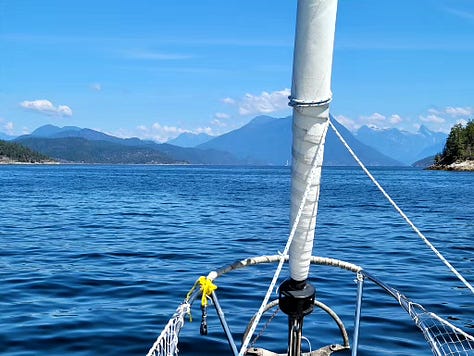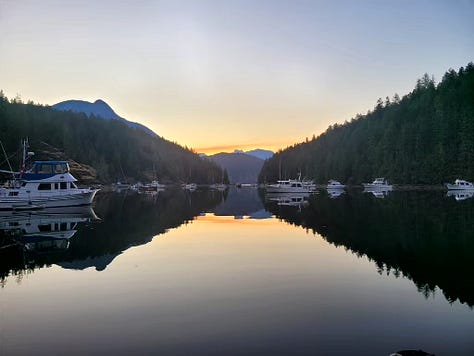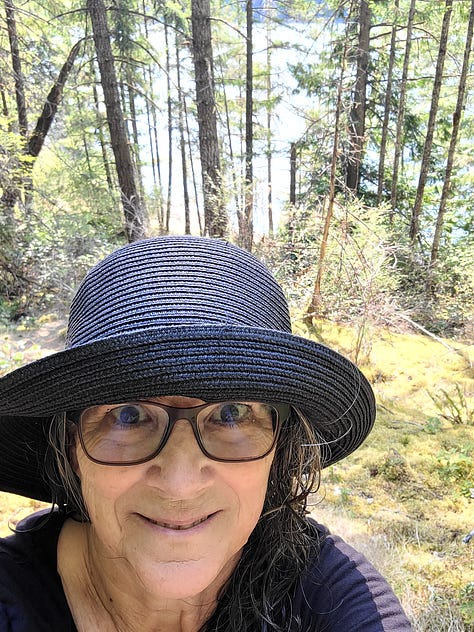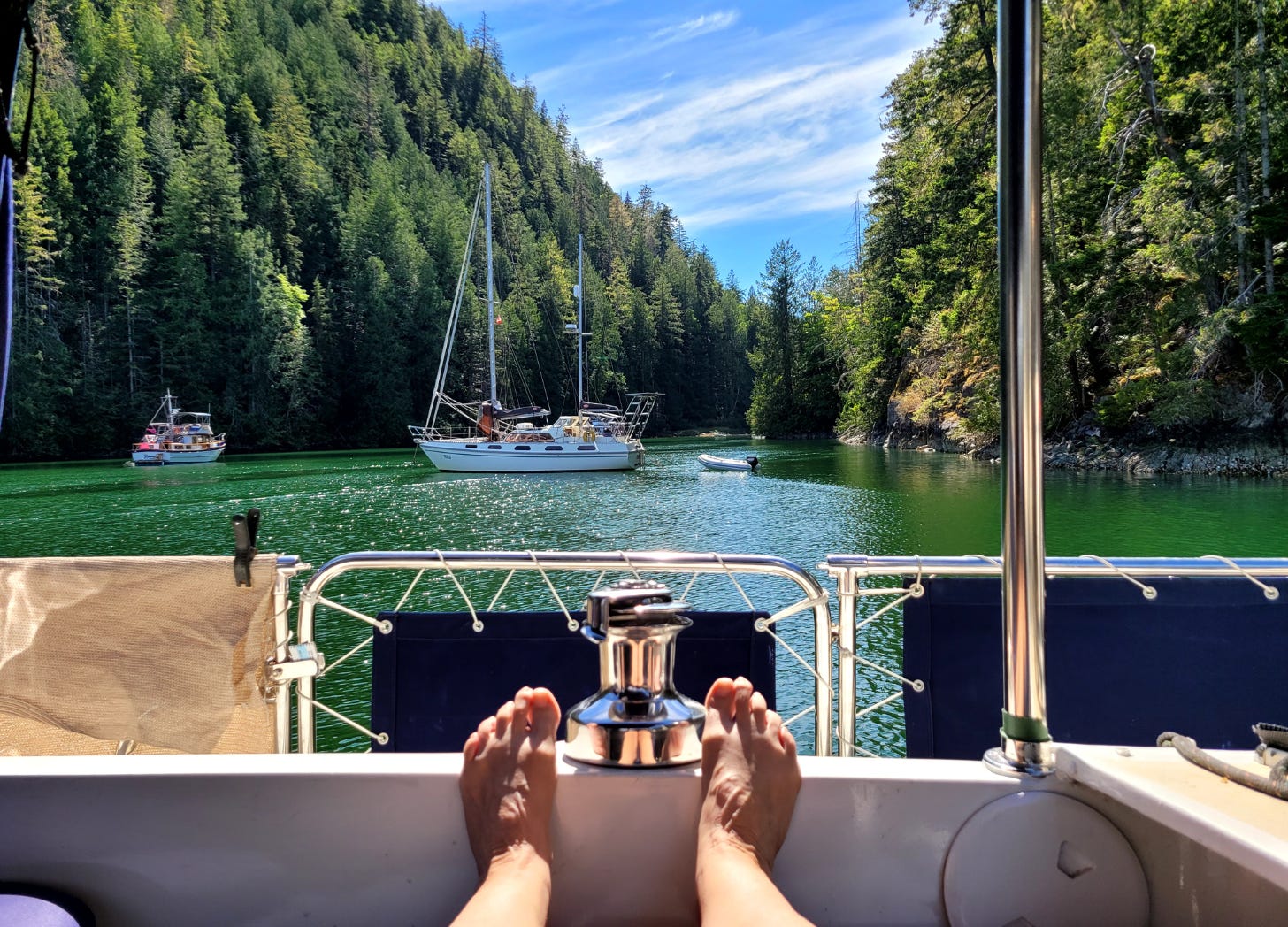Deep Delights in Desolation Sound
Our Travel Columnist forges a new (to her) path through legendarily rugged Northwest beauty.
Desolation Sound. It had been on our sailing bucket list for years. We’d talked to people who’d extolled its beauty and remoteness, read a few guidebooks and charter-boating sites to learn about favorite Sound anchorages, and seen a few dozen YouTube videos about the delights of cruising there. And now, having sailed north from Vancouver and into lovely Pender Harbor, the renowned sound was just a few days north of us.
We’d bought diesel, loaded up on fresh water, and re-provisioned at the local grocery store, knowing that supplies in the Sound would be limited. The wind had switched in our favor, with predicted southerly breezes coming up the Strait of Georgia. The current in the strait would even be running in our favor for a few hours, long enough to get us to Savary Island, off Lund, known as the gateway to Desolation Sound. It was time to go.
The first day went as planned, except that when we rounded the tip of Savary Island, expecting to find a fairly deserted stretch of beach where we could select any number of spots for anchoring, we were treated to the sight of hundreds of small fishing boats on mooring balls, as far as we could see. We groaned with frustration and fatigue—even a nice day sail is tiring, and after eight hours in the sun and wind we were ready to stop down and relax—and started motoring along the island outside the packed mooring field, in about fifty feet of water. Finally, a couple of miles down the island, I spotted a shallow area off some cliffs that didn’t have any boats anchored on it. We dropped the anchor, ate a quickly plated dinner of mustardy potato salad with hard-boiled eggs, red onions, and celery, which I’d made the previous day, and retired to read and sleep.
The next day’s sail was equally easy, though the wind was so light that we had to motor-sail the few miles from Savary up to the entrance to Desolation Sound. Then we turned off the engine, and soon turned west, sailing into one of the most incredibly gorgeous natural settings I have ever seen. The Sound is immense, with hundreds of deep-water coves and bays and plenty of shoreside resorts and campgrounds. Inhabited for millennia by various First Nations peoples, the area was “discovered” by a joint naval mapping expedition led by George Vancouver and two Spanish sea captains. I have no idea what the Spaniards thought of the Sound but Vancouver named it Desolation, claiming that “there was not a single prospect that was pleasing to the eye.”
We, however, even after all our preparatory viewings of still images and videos, were stunned into silence by the Sound’s natural beauty. I can only imagine what the Norfolk-born Vancouver thought was pleasing to the eye—tilled fields, rolling hills, and picturesque hamlets spring to mind—but a vast body of clear green water rimmed by rocky glacier-cut inlets and lush green pine forests, all backed by incredibly steep show-topped mountains seemed to scrape the deep blue sky was clearly not among them.
Grinning like fools, we texted a couple of quick photos and messages to family and close friends, and sailed on toward our first-choice anchorage of five that were nearby, all just a few miles west of our position. We lunched on an array of cheeses, soft french bread, and fresh plums. The southerly wind was light but enough to propel us west, the sun shone down on nearly still water, and there were so many options to choose from.
Two hours later, we were gritting our teeth as we motored into the wind and current, heading for the last option on the list, Roscoe Cove, which came at the bottom of the list precisely because it involved a dangerous and time-sensitive entrance. The previous four anchorages had been packed with boats, leaving nary a backyard swimming pool’s length to anchor in. Most of the vessels were large powerboats, that sported all the accoutrement of the cliche image—smoking and benching gas-powered generators and gratingly loud personal watercraft—that has earned such vessels the evocative sobriquet “stinkpots.”



A few sailboats were stern-tied to the sheer sides of these rocky coves, but though we had all the stern line required, and Russel had fashioned an efficient way to deploy it, we’d never actually performed the maneuver, and were loathe to attempt it in such close quarters with a brisk breeze building. The last anchorage we checked out was empty but we soon saw why, as the shore shoaled so precipitately that a wind shift would put us on a rocky point located smack dab in the center of the bay.
So it was Roscoe Bay or nothing—nothing meaning we’d be heading off into the fading light and freshening breeze, faced with either back-tracking to the nearest marina or heading up a long inlet to yet another limited and no-doubt-crowded anchorage. I had heard of the cove from another sailboat captain in Vancouver, and he extolled its virtues shamelessly, only to end the with a quick disclaimer of, “it is well worth it to wait for the perfect tide to get past the rocky entrance shoal.” The say what? We’d examined the chart and seen that in fact it was two slot-shaped bays, the outer one small and narrow, the inside one wider and much longer, separated by a a passage that was exposed as dry land at low tide. But the tide was coming in still, and would be high at ten pm.
It was after six when we motored into the outer bay. It was empty but we could see a great number of boats of all sizes and shapes in the inner bay. We anchored temporarily in the narrow inlet, about fifty feet from the north side and 100 feet from the south. We dined on leftover white-bean chili and listened to weather reports, hoping the tide was coming in fast enough to get through before it was dark. The forecast called for the wind to shift overnight, so Roscoe Cove would be the ideal location, if we could get in. We were nervous and full of questions: Was there still enough room for us to find a safe spot in the cove? Could we get over the bar at a medium tide without hitting the bottom? Was it too early to have a drink?
We did in fact get over the bar not long after, following in another sailboat who claimed they’d been in before and had almost as deep a keel as ours. We found a good spot to anchor for the night, and the next morning we stern-tied for the first time, with great success (The provincial parks have drilled into the rock sides of the park coves, installing long chains to tie one’s stern anchor to). We only put the dinghy in the water in order to accomplish the second half of the stern-tying process. After that, securely fastened, we relaxed in the sunny cockpit and proceeded to put a serious dent in our provisions. This was not a day for sardines—we ate ribeye steaks sautéed with kale and the last of the fresh mushrooms.
The worst part about Roscoe Bay, after getting in, was the lack of a decent cell signal (all of our wifi works off of our phones and a cellular hot spot). Luckily we’d anticipated this, so I’d warned my Substack readers and my clients that I’d be incommunicado for a few days (it ended up being a week) and I took a well-earned break from social media, and my phone in general. I was able to get a few texts out, to make sure our family knew we were okay, but being “off the grid” turned out to be the perfect way to spend a truly relaxing week of vacation.
The best part of Roscoe Bay, in addition to its remote beauty and general quiet, was the presence of a freshwater swimming hole not far away. Black Lake was a five minute walk from the far end of the cove, which was the end we were anchored closest to. Many cruisers had written of swimming and bathing in the warm fresh water. Of course warm water is one of the draws to Desolation Sound, and though the water under us was 68 degrees, I had high hopes for even warmer water at the lake.
The second day at high tide, we rowed over to the small landing beach, pulled our dinghy up and tied it to a big rock, and headed inland. The first view of the lake was at the first swimming “beach”—it was a charming spot, with clear water, lily pads, and big boulders for sunning, but it was already full up, at four people. They urged us to go on to the other beach, so we did. It was more of a hike, perhaps ten minutes further, mostly up, on a weedy deer path that served as park access.
At a turn off, we followed the sound of splashing and shouting and eventually found our way back down to the water, where massive boulders had created a rock poolside. The loud family of Canadians was friendly, and there was a separate swimming area, with its own wooden bench on which to put our hats and backpacks. We exchanged hellos and undressed down to our suits and then navigated our way off the big rocks.
Soon I’d slid over the mossy lakeside rocks and into the unbelievably clear and truly warm water. I floated on my back, my view nothing but tree tops and blue sky, and sighed with pleasure. We’d managed to find our happy place in this all-too-popular spot, and all was right with the world.





Sounds lovely!